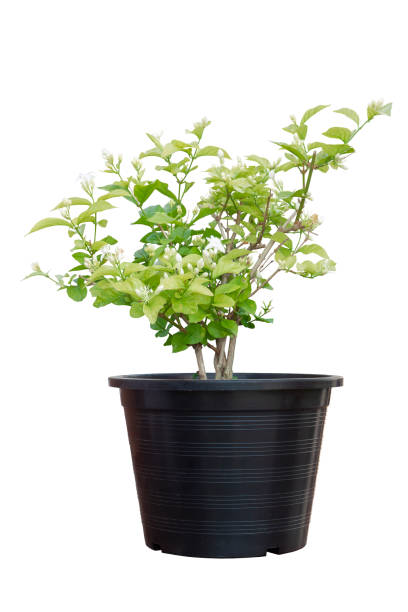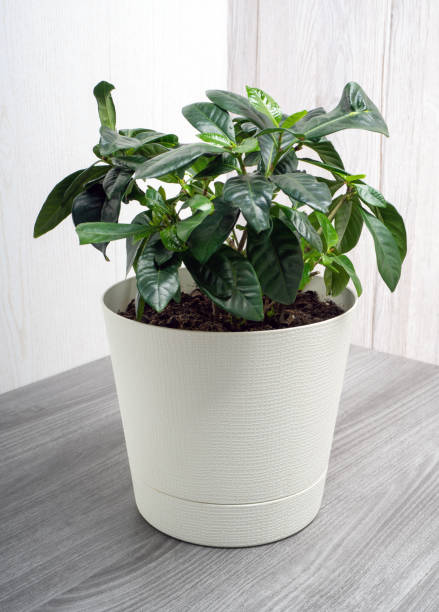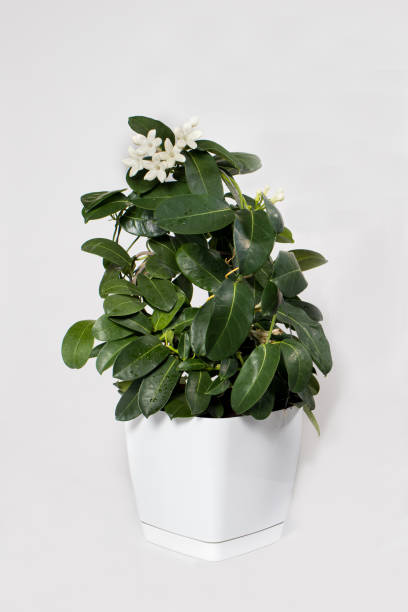Can Jasmine Grow In Pots? Tips and Tricks on Growing Jasmine in Pots
Jasmine is a fragrant plant that looks very graceful in pots. It takes almost no maintenance and can make any space look beautiful. Jasmine grows well in containers and does not need much care compared to other flowering plants. It excels in growing in pots where the air circulation is warm and dry. Growing Jasmine in pots has its challenges, but there are ways to overcome them with patience, hard work, and care.
Table of Contents
Planting Jasmine in Containers

Step 1: Choose a Large Container.
Since Jasmine rooting is exceptionally vigorous, provide it with a large container with a hole in the bottom (at least 40 cm in all directions). The hole should be big enough to allow water and air to freely circulate.
Step 2- Fill a Pot to the Brim with a Nutrient-Rich Potting Mix.
Jasmine thrives in well-drained soil. To improve the soil’s drainage, use a potting mix with a loam base or compost made from loam. Dig a 12-inch (30-cm)-deep hole and fill it with water to check the soil’s drainage.
Step 3-Choose a Spot With Some Partial Shade for the Pot.
Jasmine thrives as long as the temperature is at least 60 °F (16 °C). Locate a spot where your jasmine plant will get at least three hours of shade each day, but not all day.
Consider placing the pot near a south-facing window for maximum sunlight exposure if you’re putting it indoors.
Step 4- Plant your Jasmine
When you plant a seed, cover it with a thin layer of soil to keep it safe. If you’re planting a seedling, make sure the plant’s crown is level with the soil before you plant it. Cover all roots. As you plant the seedlings, loosen the roots with your hands to help them adapt to their new environment. This will help them grow faster. Most garden centers and nurseries sell jasmine seeds or seedlings for planting.
Step 5-After Water Immediately After Planting
Keep watering your plant until the water drains out of the drainage holes, but don’t let it dry out. It doesn’t matter what you used to do this. When the soil is damp but not wet, you should stop watering and not do anymore. Taking care of the flower right away will help keep the ground moist and help your plant get used to its new home. A spray bottle or watering can be used to mist the newly planted Jasmine after being put in the ground.

Jasmine Care Tips
- Give your Jasmine plenty of sunlight. It is best to grow all jasmine varieties in full sun. However, they can tolerate a few hours of shade each day if necessary. During the summer, you can move potted Jasmine into the light shade to protect its leaves and flower buds from overheating. A window facing south or west will produce the best results when growing indoors.
- Weekly watering is required for the jasmine plant. Keep the plant hydrated by watering with a hose or a watering can. Depending on the climate, you should water the plant once a week or whenever the soil becomes dry. Do not water the plant if you are unsure. Check first by sticking your finger in the dirt about 1–2 inches (2.5–5.1 cm) deep and see if the soil becomes moist. If the soil around the Jasmine is dry, water it.
- Every once a month, apply a potassium-rich fertilizer. Jasmine plants thrive in soil that is high in potassium. Every month from Spring to Autumn, apply NPK 10-30-10 fertilizer to the soil. You can use a liquid fertilizer high in phosphorus and potassium, such as bone meal, banana fertilizer, comfrey tea, seaweed solution, compost, or cow manure. The best fertilizer for a jasmine plant is banana peel.
- To keep the Jasmine moist, place a pebble tray or humidifier. Try using a humidifier or a water-filled pebble tray in a dry climate. Instead of placing the pot inside, open a window or put it outside if you live in a humid area.
- Remove withered leaves and flowers. Pruning your jasmine plant regularly will keep it tidy and healthy. As you notice dead leaves, stems, and flowers, use pruning shears or your fingers to remove them. Pruning more than one-third of the plant’s foliage at a time is not recommended.
- Get rid of pests. Sometimes whiteflies, caterpillars, and spider mites may attack the jasmine plant’s nectar-producing flowers. Neem oil and liquid dish soap can keep bugs away from the leaves every 15 days on both sides. Spray the leaves with the solution every 15 days on both sides. Spray the plant with a hose or mix soapy water with water to get rid of mites.
Pruning Jasmine
The long vines of the jasmine plant can be trained to grow on a trellis. Ensure you don’t prune your Jasmine after the flowers have faded if you want it to grow into a vine.
Pruning a jasmine plant is the only way to get it to grow into a bush. Pruning encourages the plant to grow. During the middle of the summer, cut back the branches by half to encourage new growth. Once a flush of flowers has faded, trim the stems.
Repotting Jasmines
Unlike most other houseplants, Jasmine does not require repotting for a long time. Jasmine likes to be snug in its pot, so wait until it’s almost potbound before moving it. Repotting Jasmine is a simple process, similar to repotting other plants, except for the many roots involved. If you time it right, your plant will grow all year.
Repotting a Jasmine Plant: When and How to Do It
The roots of a jasmine plant, like those of any other plant, encircle the pot as it grows. Roots gradually take over the potting soil until there are more roots than soil. This indicates that the amount of moisture-holding material has decreased since you first planted it. As a result, you should repot your jasmine plant if you have to water it twice in a row. The plant should be placed on its side on a newspaper, either inside or outside. Tap the sides of the pot to loosen the root ball, then slide it out. Investigate the source of the problem. If you notice any dark brown or black pieces, use a utility knife to remove them. Loosen the roots of the old potting soil as much as possible with your hands before removing it. Remove any long strands of root that have encircled the root ball. Four cuts from top to bottom should be made vertically in the root ball’s sides. Slices should be evenly spaced all around the root’s circumference. New roots will be encouraged to grow as a result of this. Plant the Jasmine in a container 2 inches (5 cm.) larger in diameter than the one it was previously housed in, using fresh potting soil.
A pot at least two inches bigger should be used to repot the Jasmine.

Potted Jasmine Varieties
As long as the soil is well-draining, jasmines can thrive. They are susceptible to root rot and other fungal diseases if their soil is constantly wet or soggy. Allowing a few inches of soil to dry between waterings during non-flowering periods will help keep the plant healthy and thriving.
Jasmines With White Flowers
Several potted jasmines have white flowers that thrive. There are many varieties, including Arabian Jasmine (Jasminum sambac). It is best grown in a pot with a trellis or other support because it grows as a bushy vine that sprawls aggressively. Star jasmine (Jasminum nitidum) has white, pinwheel-shaped flowers on strong, woody vines with narrow, shiny leaves. Although its vines can grow up to 20 feet in length, regular pruning results in an attractively dense and lush potted plant. When it comes to USDA hardiness zones 10 and 11, it can be grown outside year-round, while Arabian Jasmine can only be grown in USDA zones 9 through 11.
Jasmine With Yellow Flowers
Colorful yellow flowers are found on several potted jasmines suitable for display. For example, Chinese Jasmine (Jasminum mesnyi) can be grown year-round in USDA zones 8 through 10 as an example of an evergreen perennial. A vine that can grow up to 5 feet tall thrives in a large pot with a trellis or wire support. It has trumpet-shaped, extremely fragrant yellow flowers that bloom in the spring and early summer months. Jasminum nudiflorum (Jasminum nudiflorum) is also a good choice for a large potted plant in the winter. It blooms in the winter or early spring with bright yellow flowers that aren’t particularly fragrant. This variety of Jasmine, which gets its name from its ability to withstand cold temperatures, can be left outside year-round in USDA zones 6 through 9.
Other Jasmine
Several other jasmines thrive in containers as well. There is a fast-growing pink jasmine vine (Jasminum polyanthum) amongst these varieties. Using a circular trellis or topiary-style support is especially beautiful in a pot. With its deep rose-pink buds, the flowers open as pale-pink and highly fragrant flowers that gradually turn white as they mature. USDA zones 8 through 11 can enjoy this Jasmine. However, the downy substance on the stems and leaves of a different Jasmine, called downy Jasmine (Jasminum multiflorum), gives the entire plant an unusual gray-green appearance. It looks great in a pot and grows well on trellises, too. It can be grown outside in USDA zones 9 through 11, though.
